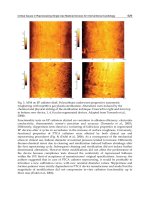Biomedical Engineering Trends in Materials Science Part 17 doc
Bạn đang xem bản rút gọn của tài liệu. Xem và tải ngay bản đầy đủ của tài liệu tại đây (6.06 MB, 30 trang )
Biomedical Engineering, Trends in Materials Science
472
interest and activity in the application of synthetic polymers in medicine, particularly for
surgical and dental implants. The most critical property of a polymeric material is that it has
acceptable tissue compatibility. If this criterion is not met, local tissue irritation may result.
In general, the chemical structure, electric charge, hydrophilicity and hydrophobilicity,
surface roughness, micro-heterogeneity, and flexibility of the materials affect the performance
of cells and tissues on the materials (Minoura,1993; Yang & Tsai, 2010). Biocompatibility can
be characterised by a whole series of negatives, for example that the material was non-toxic,
non-irritant, non-thrombogenic, non-carcinogenic and so on. Such a state of compatibility
was most likely to be achieved by a material being inert and unrecognisable by the tissue. A
desirable property of a synthetic polymeric material used in biomedical applications is that
it has acceptable tissue compatibility. If this criterion is not met, local tissue irritation may
result. One particular method used to obtain these desired properties is grafting hydrophilic
compounds namely a hydrogel onto hydrophobic backbones. Hydrogels have physical
properties similar to those of human tissue and possess excellent tissue compatibility and
are used as biomedical materials. The main disadvantages of hydrogels are their poor
mechanical properties after swelling. To overcome this problem, Yang & Hsiue (1996)
grafted hydroxyethyl methacrylate (HEMA) onto SBS via UV radiation. The mechanical
properties of SBS-g-HEMA were found to be superior to those of poly(HEMA) and were
identical to those of SBS. From their measurements, the contact angle and blood clotting
time, the wetting and non-thrombogenic properties of SBS-g-HEMA were better than those
of SBS. Yang et al., (1997) have also researched into the graft copolymerisation of dimethyl
amino ethyl methacrylate (DMAEMA) with SBS and it was found that the degree of grafting
was related to the irradiation time, DMAEMA concentration and temperature, but the
adsorption of albumin and fibrinogen decreased with an increase in the amount of grafting.
They continued on their work by the substitution of amino groups on the SBS-g-DMAEMA
graft copolymer membrane which was treated with heparin to prepare the heparin
containing SBS-g-DMAEMA (SBS-g-DMAEMA-HEP). It was found that, with increased
grafting and heparin content, the surface tension and the water content of the SBS-g-
DMAEMA membrane increased whereas the contact angle decreased (Yang et al., 1998).
Over the past few years, N-isopropylacrylamide (NIPAAm) has appeared in the literature
with increasing frequency (Durne et al., 2005; Zhang et al., 2005; Geever et al., 2008; Geever
et al., 2007; Geever et al., 2006; kennedy et al., 2009). Lee and Chen (2001) have grafted N-
isopropylacrylamide (NIPAAm) onto SBS via solution polymerisation using benzoyl
peroxide as the initiator. This was carried out to improve the water absorption and thermo
sensitivity of SBS.
Thus, a biomedical material often needs to function dependably without
significantly altering the physical or mechanical properties of the substrate. Kennedy et
al.,(2009, 2010) have successfully grafted SBS with acrylic acid (AA) and SBS with
N- isopropylacrylamide(NIPAAm) respectively via UV polymerisation techniques for use as
a potential biomedical material and in doing so; they proved that the glass transition values
for each of the grafted copolymers increased in the butadiene domain, thus proving that
grafting had occurred.
8. Synthesis of graft copolymers of SBS via UV polymerisation
UV polymerisation has become a well established technology which has found a large
number of industrial applications due to the relative ease in which the reaction occurs. In
Synthesis and Characterisation of Styrene Butadiene
Styrene Based Grafted Copolymers for Use in Potential Biomedical Applications
473
general, a liquid resin containing a photoinitiator (Benzophenone (BP)), is transformed into
a solid polymer simply by exposure to UV light (Xiang et al., 2001; Murata et al., 2004; Rohr
et al., 2003; Kim et al., 2002). In order to ascertain a possible reaction site of the base
polymer, Mateo et al.,(2000)
investigated the photoreactions of model compounds of SBS
structures 1-heptene, 3-heptenes and cumene. They concluded that the main photoreaction
induced by BP in heptene derivatives, models of the cis, trans and vinyl-double bonds of the
polybutadiene sequences, is the abstraction of an allylic hydrogen atom by the BP, and that,
in minor extension of other hydrogen atoms of the heptene aliphatic chain. In developing
grafted systems it was considered by the authors that the allylic hydrogen associated with
butadiene in SBS copolymers reacted with the hydrogel monomers using benzophenone via
UV polymerisation, as illustrated in Figures 7 and 8 respectively.
C
6
H
5
C
6
H
5
n
etc.
.
R
R
R
C
6
H
5
C
6
H
5
n
.
O
HN
n-isopropylacrylamide
O
HN
n-isopropylacrylamide
R =
O
HN
C
6
H
5
C
6
H
5
Initiator/UV light
C
6
H
5
C
6
H
5
n
n
CHCl
3
.
Fig. 7. A scheme showing the reaction of SBS and NIPAAm to yield SBS-g-NIPAAm
copolymers (Kennedy et al.,2010).
Biomedical Engineering, Trends in Materials Science
474
R
C
6
H
5
C
6
H
5
Initiator/UV light
C
6
H
5
C
6
H
5
n
n
C
6
H
5
C
6
H
5
n
C
6
H
5
C
6
H
5
n
etc.
CHCl
3
.
.
.
R
R
N
O
n-vinylpyrrolidinone
N
O
n-vinylpyrrolidinone
R =
N
O
Fig. 8. A proposed scheme illustrating the reaction of SBS and NVP to yield SBS-g-NVP
copolymers using Benzophenone as the initiator (Kennedy & Higginbotham, 2010)
9. Thermal-mechanical analysis of the grafted SBS copolymers
To appreciate the importance of these materials for biomedical use, one needs to understand
the thermal properties associated with the grafted copolymers. From experimental data
(Kennedy et al., 2010) the authors present DSC thermographs showing several
concentrations of SBS-g-NIPAAm copolymers (Figure 9). As depicted by the DSC
thermographs, exothermic variability existed in the temperature region between 50 and
200°C for each of the grafted copolymers. This variability was the result of both the
breakdown of crosslink's which were formed within the SBS copolymer during UV
polymerisation and the polymerisation of the monomers to form homopolymers. It was
Synthesis and Characterisation of Styrene Butadiene
Styrene Based Grafted Copolymers for Use in Potential Biomedical Applications
475
found, by exposing SBS to concentrated UV light, crosslinking takes place which has an
effect on the flexibility of the material. When analysing the butadiene domain, all of the
grafted samples have a broad thermal transition when compared to the PB domain of SBS.
According to Rohr et al.,(2003) graft copolymerisation can also occur between the
homopolymers, thus creating branched or crosslinked architectures. However, within the PB
domains, the grafted copolymers that contained higher concentrations (3, 3.5 and 4 mL) of
monomer followed the same thermal profile as that of SBS. This behaviour suggests that the
pure monomer reacted more readily with itself forming a homopolymer, thus reducing the
amount of grafting taking place, thus, increasing the variability within the system. The
grafted copolymers which contain monomer concentrations below 2.5mL have broader DSC
thermographs within the butadiene rich domain resulting in T
g
values of the grafted
samples being shifted up wards in the sub ambient domain, suggesting that grafting had
occurred within this region, which coincides with the reaction sequences as presented in
Figure 7. Similar observations were also found when SBS was grafted onto NVP via DSC
analysis.
Fig. 9. DSC thermographs of SBS-g-NIPAAm resulting from the reaction of SBS and various
concentrations (0.5, 1.0, 1.5, 2.0, 2.5, 3.0, 3.5 and 4.0 g) of NIPAAm.
From DSC analysis it can be speculated that grafting took place for each of the samples
tested. However, to further verify the presence of grafting, Dynamic Mechanical Thermal
Analysis (DMTA) studies can be utilised (Kennedy et al., 2010). In each of the loss tangent
thermograms, illustrated in Figure 10, the peak height of the tan δ value corresponds to the
glass transition (T
g
) of the samples being tested. From thermogram shown in Figure 10, a tan
δ value for SBS can be detected at -92°C which is associated with the polybutadiene
segment. However, there was an increase in tan δ from -92°C to -79°C for non-washed SBS-
g-NIPAAm copolymer, indicated that grafting had occurred. This reduction in the tan δ is
an indication that the backbone of the SBS copolymer has lost some of its flexibility, due to
Biomedical Engineering, Trends in Materials Science
476
the grafting of a hydrogel to its backbone. To back up this claim, the samples were washed
in chloroform under soxhlet extraction for eight days and the tan δ value shifted to -74°C.
Therefore, it is evident that the tan δ values for each of the samples tested increased,
establishing that grafting had occurred onto various butadiene segments along the SBS
backbone. Thus, suggesting that grafting will increase the T
g
of the PB phase by increasing
the thermal energy required to free polymer molecules from additional constraints.
Fig. 10. DMTA spectra representing SBS, non-washed SBS-g-NIPAAm and washed
SBS-g-NIPAAm samples after 8 days.
10. Spectral analysis of the grafted SBS copolymers
Infrared spectroscopy has been a valuable technique for materials analysis in the laboratory
for over seventy years. An infrared spectrum represents a fingerprint of a sample with
absorption peaks which correspond to the frequencies of vibrations between the bonds of
the atoms making up the material. Because each material is a unique combination of atoms,
no two compounds produce the exact same infrared spectrum. Therefore, infrared
spectroscopy can result in a positive identification (qualitative analysis) of every different
kind of material. In addition, the size of the peaks in the spectrum is a direct indication of
the amount of material present. With modern software algorithms, infrared is an excellent
tool for quantitative analysis. The technique of Attenuated Total Reflectance (ATR) has in
recent years revolutionised solid and liquid sample analyses because it combats the most
challenging aspects of infrared analyses, namely sample preparation and spectral
reproducibility. Within the context of this work Fourier transform infrared spectroscopy
was carried out using the Attenuated Total Reflectance (ATR-FTIR) technique as this
generated the best results for the study. ATR-FTIR spectroscopy was carried out on SBS,
NIPAAm and SBS-g-NIPAAm copolymers as shown in Figure 11. The main bands for
characterising the butadiene segment within SBS (Figure 11 (a)) are CH
2
scissoring at 1449
cm
-1
, trans-1,4 C=C out of phase deformation at 964 cm
-1
, =CH stretching at 3005 cm
-1
and C-
H stretching at 2916 and 2844 cm
-1
. Regarding the PS segments, styrene absorption occurs at
697 cm
-1
, C-H out of plane deformation occurs at 3060 cm
-1
and at 1601 cm
-1
aromatic C-C
stretching occurs (Munteanu & Vasile, 2005; Romero-Sanchez et al., 2005a; Romero-Sanchez
Synthesis and Characterisation of Styrene Butadiene
Styrene Based Grafted Copolymers for Use in Potential Biomedical Applications
477
et al., 2005b). The ATR-FTIR spectrum for NIPAAm shown in Figure 11(b) illustrates bands
corresponding to C=O stretching and NH bending for secondary amides at 1655cm
-1
and
1544cm
-1
. These bands are present as small shoulders in SBS-g-NIPAAm copolymer shown
in Figure 11 (c). The peak at 1545 cm
-1
for NIPAAm and SBS-g-NIPAAm copolymer was
assigned as a symmetric deformation of NH
3
+
.
These results correspond to the finding of
Erbil et al., (2004) and Ju et al.,(2002). However, the peaks present at 1617 cm
-1
(C=C) and
1407 cm
-1
(CH2=) in the NIPAAm spectrum disappeared for SBS-g-NIPAAm copolymer as
illustrated in Figure 11(b). This suggests that NIPAAm had grafted to SBS resulting in the
loss of the double bond associated with the monomer.
Fig. 11. Comparisons between the different ATR-FTIR spectrums where (a) is SBS (b) is
NIPAAm and (c) is SBS-g-NIPAAm.
ATR-FTIR spectral analysis was used in conjunction with the DSC thermographs to analyse
SBS-g-NVP copolymers. For illustrative purposes spectra containing non grafted NVP
which polymerised to poly N-vinyl-2-pyrrolidinone (PVP), SBS-g-NVP using 2.5 g of NVP
and SBS are shown in Figure 12. In the case of the PVP spectrum, Figure 12 (a), a broad
C=O stretching band was found at 1650 cm
-1
which corresponds to results obtained by
Devine & Higginbotham (2003). Certain authors have found an absorption band for PVP at
1660cm
-1
and this is called amide I. This band is a combined mode with contributions of
C=O and C-N stretching (Muta et al., 2002; Cheryl & Youngli, 2002). ATR-FTIR spectrum for
the grafted sample depicted in Figure 12 (c) exhibited a peak at approximately 1664 cm
-1
,
corresponding to the carbonyl group of PVP, which indicates monomeric growth of the
grafted side chain. Szaraz et al.,(2000)
has found that for pure liquid NVP two very strong
bands occur in the IR spectrum. The band at 1629 cm
-1
, is a carbon-carbon double bond,
corresponding to olefinic C=C stretching which is usually found in the region of 1680-1630
cm
-1
. The band at 1706 cm
-1
is due to carbonyl stretching between 1750 -1700 cm
-1
. However,
as shown in the ATR-FTIR spectrum for grafted SBS-g-NVP copolymer, a small shoulder
formed at 1714 cm
-1
indicating that carbonyl stretching had occurred. This band is
associated with un-reacted NVP as outlined by Szaraz et al., (2000) suggesting that NVP is
still present within the grafted matrix, and so there is need to wash the samples after they
have been fully synthesised.
Biomedical Engineering, Trends in Materials Science
478
Fig. 12. Comparisons between the different ATR-FTIR spectra where (a) is PVP, (b) is SBS
and (c) is SBS-g-NVP. (Kennedy & Higginbotham, 2010)
11. Topography of SBS and the grafted SBS coatings
Improved compatibility is a desired feature for biomedical product such as a coating which
comes in contact with blood during clinical use. The response of blood to a foreign material
can be aggressive, resulting in surface-induced thrombus (clot) formation, which can impair
or disable the function of the coating and most importantly threaten a patient’s health. In
light of the biomedical potential of SBS based copolymers it is important to have a firm
understanding of the materials surface properties. In order to minimise interfacial problems
between the host tissues and the fluids, a biomedical material must exhibit a specific surface
chemical behaviour (Yang & Tsai, 2010; Adamson, 1990; Andrade, 1985). All synthetic
materials used in blood-contacting medical coatings promote surface-induced thrombotic
phenomena to various extents. These events are initiated by non-specific protein adsorption
followed by platelet adhesion, activation and aggregation on the biomaterial surface. The
resulting thrombus can impair the function of the implanted devices, while thromboembolic
events can occlude blood vessels leading to serious cardiovascular complications. Hence,
non-thrombogenicity is a highly desired surface property for blood-contacting biomaterials.
Thus, surface roughness is of significant interest in biomedical coatings because it is an
important property which influences friction as well as wettability when in contact with a
biological environment.
11.1 White light profilometry
One method of determining surface values of a material is to employ a technique known as
White light profilometry which scans a surface using white light, thus providing surface
structural analysis without using physical contact. The surfaces are characterised using
amplitude parameters such as average surface roughness (Ra) or root mean square (RMS)
roughness which can be summarised by a single “average roughness” value which is a close
approximation of the arithmetic average roughness-height, calculated from the profile chart
Synthesis and Characterisation of Styrene Butadiene
Styrene Based Grafted Copolymers for Use in Potential Biomedical Applications
479
of the surface. The Ra value is the average deviation of all points, calculated using equation
1, from a plane fit of the test surface. A graphic representation showing how Ra is conceived
is illustrated in Figure 13.
()
0
1
L
a
Rzxdx
L
=
∫
(1)
Fig. 13. Illustration of the average roughness, Ra, where z(x) is the surface height in point x
relative to a mean line and L is the overall length of the profile under examination.
The standard deviation of the profile heights, RMS, is a parameter calculated by the average
of the square roots of all of the Ra values. This parameter is the most widely used and its
numerical value is about 11% higher than the Ra value. This parameter is calculated using
equation 2.
()
2
0
1
L
RMS z x dx
L
=
∫
(2)
The height of a selected material can be evaluated using Peak to Valley (PV) value which is
the distance between the highest and lowest points within the sample. A graphical
representation of how a PV value is determined is illustrated in Figure 14.
Fig. 14. Illustration of the peak to valley height (PV).
Kennedy et al.,(2010) used this technique to evaluate the roughness and height of SBS-g-
NIPAAm grafted copolymers. As illustrated in Figure 15, the root mean square (RMS), as
well as Peak to Valley (PV) values were 0.128µm and 1.651µm respectively for the SBS
copolymer. However, when these values were compared to a SBS-g-NIPAAm and SBS-g
NVP copolymers as shown in Figures 16 and 17 respectively, the RMS parameter (1.125µm
for SBS-g-NIPAAm and 0.859µm for SBS-g-NVP) and the PV value (13.878µm for SBS-g-
Biomedical Engineering, Trends in Materials Science
480
NIPAAm and 6.896µm for SBS-g-NVP) were greater than that of SBS. It was found that the
PV of each of the grafted copolymers tested was influenced by monomeric concentrations
and the amount of chloroform (used to dissolve SBS) still present in the sample after UV
polymerisation. This is an important property characteristic which directly affects the non-
thrombogenic properties of the material within a specific biological environment i.e. the
smoother the surface, the less likely that thrombosis will occur. However, this roughness
may aid in the muco-adhesion properties of the material which is advantageous in
biological environments such as arteries.
Fig. 15. A white light profilometry scan for a SBS copolymer illustrating 2D and 3D surface
profiles as well as the PV value, 1.651µm and the RMS parameter, 0.128µm.
Fig. 16. A white light profilometry scan for a SBS-g-NIPAAm copolymer illustrating 2D and
3D surface profiles as well as the PV value, 13.878µm and the RMS parameter, 1.125µm.
Synthesis and Characterisation of Styrene Butadiene
Styrene Based Grafted Copolymers for Use in Potential Biomedical Applications
481
Fig. 17. A white light profilometry scan for a SBS-g-NVP coating illustrating 2D and 3D
surface profiles as well as the PV value, 6.896µm and the RMS parameter, 0.859µm.
11.2 Scanning electron microscopy
SEM micrographs of SBS, selected grafted polymers are illustrated in Figures 18 to 20.
(a)
(b)
Fig. 18. SEM images of SBS at resolutions of 50µm (a) and 10 µm (b).
Biomedical Engineering, Trends in Materials Science
482
Mohammady et al., (2002) has confirmed that SBS, kraton D1101, exhibits a mixture of PS
cylinders and lamellae embedded in the PB matrix when analysed by SEM. These findings
correspond with observations made by the Authors, as shown in Figure 18, where SBS
exhibits a uniform and dense structure with no pores present whereas the remaining grafted
samples illustrated in Figures 19 and 20 revealed porous sponge like membranes due to the
migration of chloroform during the UV polymerisation process.
(a) (b) (c)
Fig. 19. SEM images of SBS-g-NIPAAm at resolutions of 50µm (a), 10µm (b) and 2µm (b).
(a) (b) (c)
Fig. 20. SEM images of SBS-g-NVP at resolutions of 50µm (a), 10µm (b) and 2 µm (c).
11.3 Contact angle analysis of SBS and grafted SBS copolymers
For the fabrication of biomedical coatings coming into contact with blood and tissue, it is
usually desirable to create or utilise materials which exhibit high degrees of wettability. One
technique used to predict wetting properties of biomedical polymers is the use of contact
angles. When a droplet impacts onto a solid surface, a liquid film is formed which spreads
out with a retarding velocity, due to the influence of both the surface tension and surface
forces, resulting in the liquid film attaining a maximum spread when it comes to a stop.
Young’s law provides a relation between those forces outlined in equation 3.
Synthesis and Characterisation of Styrene Butadiene
Styrene Based Grafted Copolymers for Use in Potential Biomedical Applications
483
.cos
lv ls sv
σ
θσ σ
+
= (3)
where θ is the angle of contact the liquid makes on the solid, σ
lv
, σ
ls
, and σ
sv
represent the
interfacial tensions at the boundaries between liquid (l), solid (s) and vapour (v).The contact
angle, θ, is usually referred as the wettability of a surface. The liquid is non-wetting when
90° < θ < 180° and wetting when 0°< θ < 90° (Moite & Moreira, 2003). Wettability can be
assessed directly using goniometry by measuring the angle formed between a solid surface
and the tangent to the drop surface. A graphic illustrating the concept of wettability is
shown in Figure 21.
Fig. 21. A graphical representation of wettability.
Therefore, wettability is often referred to as hydrophilicity and is considered to be a surface
property of a material as opposed to true hydrophilicity, which is considered to be a bulk
property. A caveat to this design criterion is the fact that polymers are generally
hydrophobic in nature due to their generally low surface tensions, resulting in polymers
exhibiting poor wettability. For visual purposes, to illustrate principles of wettability, a
digital goniometer was used and the results are illustrated in Figure 22, these images best
demonstrate the affect of wettability on SBS as well as grafted SBS copolymers.
(a) 113° (b) 52° (c) 6°
Fig. 22. Contact angles representing the copolymers, where (a) SBS, (b) SBS-g-NIPAAm and
(c) SBS-g-NVP.
From the images obtained the modification in the surface chemistry and wettability is
reflected by the dramatic reduction in the contact angles as shown in Figures 22. Lassalle et
al.,(2004) has found a contact angle of 95° when 1% of N-carbamyl maleamic acid was
grafted onto SBS. Whereas, Yang et al.,( Yang 7Hsiue, 1996; Yang et al., 1997; Yang et al.,
1998) reported similar trends when vinyl pyridine was grafted onto SBS and when dimethyl
amino ethyl methacrylate was grafted onto SBS, contact angles of 77° and 76° were obtained.
Biomedical Engineering, Trends in Materials Science
484
Therefore, by grafting a hydrophilic monomer/polymer onto a hydrophobic backbone the
wettability of the material is increase. It is important to note, that the samples tested where
not washed and the low contact angle for the SBS-g-NVP copolymer was in part due to the
migration on polymerised poly N- vinyl-2-pyrrolidone which is an excellent hydrophilic
hydrogel, but the principle still applies whereby a hydrophobic material such as SBS can be
made into a hydrophilic compound via grafting technologies.
12. Conclusion
Polymer science is by nature an interdisciplinary field, where it has found refuge in the
traditional domains of engineering, chemistry and physics. However, the importance of this
branch of science has now expanded and by the further integration of other disciplines such
as biology, medicine and computing, new innovations have emerged resulting in
opportunities which very much find itself in the fields of biomaterials. This chapter looked
at such possibilities, where the tradition SBS copolymer (a thermoplastic elastomer) was
modified into a grafted copolymer utilising hydrogel technology to create a potential
medical application in the area of biomedical coatings.
To truly appreciate the breath and depth of the opportunities one must have a detailed
understanding of the fundamental principles which occur within the materials such as phase
separation, the domain theory, topography and reaction kinetics to name but a few. Only then
can new materials be commercialised which capture the needs society has place on them.
13. References
Adamson, A.W. (1990).Physical Chemistry of Surfaces, Wiley, ISBN-13: 978-0471610199, New
York,
Adhikari, R; Michler, GH; Godehardt,R; Ivan'kova EM.(2003). Deformation behaviour of
styrene butadiene star block copolymer/hPS blend: influence of morphology.
Polymer, Vol., 44, No., 26 (December 2003) pp 8041-8051, ISSN 0032-3861
Adhikari, R; Michler, GH; Knott, RB.(2004). Morphology and micromechanical behaviour of
binary blends comprising block copolymers having different architectures. Polymer,
Vol., 45, No., 1(January 2004) pp 241-246, ISSN 0032-3861
Andrade, J.D.(1985). Surface and Interfacial Aspects of Biomedical Polymers: Surface Chemistry
and Physics Vol. 1, Plenum Publications, ISBN-13: 978-0306417412, New York.
Brydson, J.A.(1978) Rubber Chemistry, Applied Science Publishers, ISBN-13: 978-0853344360,
London.
Burford, RP; Markotsis, MG; Knott, RB.(2003) Small angle neutron scattering and
transmission electron microscopy studies of interpenetrating polymer networks
from thermoplastic elastomers. Nuclear Instruments and Methods in Physics Research
Section B: Beam Interactions with Materials and Atoms, Vol.208, pp 58-65, ISSN 0168-
583X
Cheryl, L; Youngli, M.(2002). A study of blending and complexation of poly(acrylic
acid)/poly(vinyl pyrrolidone). Polymer, Vol. 43 , No. 3, (February 2002) pp 823-
829, ISSN : 0032-3861
De Sarkar, M; De, PP; Bhowmick, AK.(1999). Influence of hydrogenation and styrene
content on the unaged and aged properties of styrene-butadiene copolymers. J.
Material Science, Vol. 34, No.8(April 1999), pp 1741-1747, ISSN 0022-2461
Synthesis and Characterisation of Styrene Butadiene
Styrene Based Grafted Copolymers for Use in Potential Biomedical Applications
485
Devine D.M; Higginbotham C.L.(2003). The synthesis of a physically crosslinked NVP based
hydrogel. Polymer, Vol. 44, No.26 (December 2003 ), pp7851-7860, ISSN 0032-3861.
Durne, KV; Mele, B; Loos, W; Du Prez, F.(2005). Introduction of silica into thermo- responsive
poly(N-isopropylacrylamide) hydrogels. A novel approach to improve response
rates. Polymer, Vol. 46, No.23 (November 2005), pp 9851-9862, ISSN 0032-3861
Erbil, C; Kazancioglu, E; Uyanik, N.(2004). Synthesis, characterisation and thermoreversible
behaviours of poly (dimethylsiloxane)/ poly(N-isopropylacylamide) semi -
interpenetrating network, European Polymer Journal, Vol. 40, No.6 (June 2004), pp
1145-1154, ISSN 00143057.
Escobar-Barrios,VA; Najera,RH; Petit,A ; Pla, F.(2003). Selective hydrogenation of butadiene
styrene copolymers using a Ziegler-Natta type catalyst 2. Thermal properties
European Polymer Journal, Vol. 39,No.6 (June 2003), pp 1151-1167, ISSN 0014-3057
Geever, L.M.; Cooney, C.C; Lyons, J.G; Kennedy, J.E; Nugent, M. J.D; Devery,S;
Higginbotham, C.L.(2008). Characterisation and controlled drug release from novel
drug-loaded hydrogels, European Journal of Pharmaceutics and Biopharmaceutics, Vol.
69, No.3 (August 2008), pp 1147-1159, ISSN 0939-6411.
Geever, L.M; Devine, D.M; Nugent, M. J.D; Kennedy, J.E; Lyons, J.G; Hanley, A;
Higginbotham, C.L.(2006). Lower critical solution temperature control and
swelling behaviour of physically crosslinked thermosensitive copolymers based on
N-isopropylacrylamide, European Polymer Journal, Vol. 42, No.10 (October 2006),
pp 2540-2548, ISSN 0014-3057.
Geever, L.M; Mínguez, C, M; Devine, D.M; Nugent, M. J.D; Kennedy, J.E; Lyons, J.G;
Hanley, A; Devery, S; Tomkins, P.T; Higginbotham, C.L.(2007). The synthesis,
swelling behaviour and rheological properties of chemically crosslinked
thermosensitive copolymers based on N-isopropylacrylamide, Journal of Materials
Science, 2007 Vol. 42, No.12 (March 2007), pp 4136-4148, ISSN : 0022-2461.
Gruver, J.T; Kraus, G.(1964). J.Appl.Polym.Sci. Pt A 2, pp 797, cited in Holden, G;
Kricheldorf H.R; Quirk R.P Editors(2004). Thermoplastic Elastomers, Hanser, ISBN
9783446223752, Munich.
Hirata, I.(2004). Simple method for preparation of ultra-thin poly(N-isopropylacrylamide)
hydrogel layers and characterization of their thermo-responsive properties,
Polymer, Vol. 45, No.16 (July 2004), pp 5569-5578, ISSN 0032-3861.
Holden G. J. (1965) Appl. Polym. Sci. Vol 9, pp 2911, cited in Holden, G; Kricheldorf H.R; Quirk
R.P Editors(2004). Thermoplastic Elastomers, Hanser, ISBN 9783446223752, Munich.
Holden, G; Kricheldorf H.R; Quirk R.P Editors(2004). Thermoplastic Elastomers, Hanser, ISBN
9783446223752, Munich.
Holden, G; Hansen, D.R. (2004). Styrenic Thermoplastic Elastomers. pp 45-65. In: Holden, G;
Kricheldorf H.R; Quirk R.P Editors(2004). Thermoplastic Elastomers, Hanser, ISBN
9783446223752, Munich.
Holden, G; Milkovich,R.(1962) (to shell oil co), U.S. Patent 3,265,765, filed January 1962.
Huang, NJ; Sundberg, DC. (1995 a). Fundamental Studies of Grafting Reactions in Free
Radical Copolymerisation. 1. A Detailed kinetic Model for Solution Polymerisation.
Journal of Polymer Science Part A, Polymer Chemistry, Vol. 33, No.15 (November
1995), pp 2533-2550, ISSN 0887-624X .
Huang, NJ; Sundberg, DC. Fundamental Studies of Grafting Reactions in Free Radical
Copolymerisation.2.(1995b). Grafting of Styrene, Acrylate, and Methacrylate
Monomers onto cis-Polybutadiene Using AIBN Initiator in Solution
Biomedical Engineering, Trends in Materials Science
486
Polymerisation. Journal of Polymer Science Part A: Polymer Chemistry, Vol. 33,
No.15 (November 1995), pp 2551-2570, ISSN 0887-624X.
Huang, NJ; Sundberg, DC.(1995 c). Fundamental Studies of Grafting Reactions in Free
Radical Copolymerisation.3. Grafting of Styrene, Acrylate, and Methacrylate
Monomers onto cis-Polybutadiene Using Benzoyl Peroxide Initiator in Solution
Polymerisation. Journal of Polymer Science Part A, Polymer Chemistry, Vol.
33,No.15 (November 1995), pp 2571-2586, , ISSN 0887-624X.
Huang, NJ; Sundberg, DC.(1995 d). Fundamental Studies of Grafting Reactions in Free
Radical Copolymerisation.4. Grafting of Styrene, Acrylate, and Methacrylate
Monomers onto vinyl-polybutadiene using benzoyl peroxide and AIBN Initiators
in Solution Polymerisation. Journal of Polymer Science Part A, Polymer Chemistry,
Vol. 33,No.15 (November 1995), pp 2587-2603 , ISSN 0887-624X.
Jiang, DD; Wilkie, CA.(1998). Graft copolymerisation of Methacrylic acid, Acrylic acid and
Methyl acrylate onto Styrene- butadiene Block copolymers. Eur. Polym. Journal,
Vol. 34, No.7 (July 1998), pp997-1006, ISSN 0014-3057.
Ju, H.K; Kim, S.Y; Kim, S.J; Lee ,Y.M.(2002). pH/Temperature responsive semi-IPN
hydrogels composed of alginate and poly(N-isopropylacrylamide), J Appl Polym
Sci. Vol. 83, No. 5(January 2002), pp 1128-1139, ISSN 0021-8995 .
Kennedy, J.E; Devine, D.M; Lyons J.G; Geever, L.M; Higginbotham, C. L.(2009). The
synthesis and characterisation of grafted random styrene butadiene for biomedical
applications. Journal of Materials Science, Vol. 44., No. 3(February 2009) pp 889-896,
ISSN 1573-4803.
Kennedy, JE; Higginbotham, CL.(2010). Synthesis and characterisation of styrene butadiene
styrene-g-N-isopropylacrylamide via UV polymerisation for potential use in
biomedical applications, Journal of Materials Science, Vol. 45, No. 3 (February 2010),
pp 599-606, ISSN 0022-2461.
Kennedy, JE; Higginbotham, CL.(2010) Synthesis and characterisation of styrene butadiene
styrene-g-N vinyl -2-pyrrolidinone for use in biomedical applications, Materials
Science and Engineering C, doi:10.1016/j.msec.2010.09.004
Kennedy, JE; Lyons, JG; Geever, LM; Higginbotham, CL.(2009) Synthesis and
characterisation of styrene butadiene styrene-g-acrylic acid for potential use in
biomedical applications, Materials Science and Engineering C, Vol. 29, No.5 (June
2009), pp 1655–1661, ISSN 0928-4931
Kim, J. K; Kim, W. H; Lee, D. H.(2002). Adhesion properties of UV crosslinked polystyrene-
block-polybutadiene-polystyrene copolymer and tackifier mixture. Polymer, Vol. 43,
No.18 (August 2002), pp 5005-5010, ISSN 0032-3861.
Knoll, K; Niessner, N.(1998). Styrolux+ and styroflex+ : From transparent high impact
polystyrene to new thermoplastic elastomers syntheses, applications and blends
with other styrene based polymers. Proceedings of Macromol. Symp, pp 231-243,
ISBN 3-527-29800-2, Paris, 7-11 July, 1997, Wiley-VCH, Switzerland
Lasalle, V.L; Failla, M.D; Valles, E.M; Martin-Martinez, JM.(2004). Chemical modification of
styrene-butadiene-styrene co-polymer by grafting of N- carbamyl maleamic acid, J
Adhesion Sci. Technol, Vol. 18, No. (15-16), pp1849-1860, ISSN 0169-4243 .
Lee, W; Chen, Y. Graft copolymerisation of N-isopropylacrylamide on styrene-butadiene-
styrene block copolymer.(2001). Journal of Applied Polymer Science, Vol. 82, No.11
(December 2001), pp 2641-2650, ISSN 0021-8995.
Synthesis and Characterisation of Styrene Butadiene
Styrene Based Grafted Copolymers for Use in Potential Biomedical Applications
487
Madhusudhan, RB; Raghunath, RP.(1999). Grafting of maleic anhydride onto acrylonitrile-
butadiene-styrene ter-polymer: synthesis and characterization. Polym Plast Technol
Eng, Vol. 38, No.5 (November 1999), pp 967-977, ISSN 0360-2559.
Mateo, JK; Bosch, P; Serrano, J; Calvo, M.(2000). Sorption and diffusion of organic solvents
through photo crosslinked SBS block copolymers, European Polymer Journal, Vol. 36,
No.9 (September 2000), pp 1903-1910, ISSN 0014-3057.
Minoura, F.N., Soft tissue compatible polymers.(1993) In: Biomedical Applications of Polymeric
Materials, Tsuruta, T; Hayashi, T; Kataoka, K; Ishihara, K; Kimura, Y. Editors, p.
118. CRC Press, ISBN-13: 9780849345197, Boca Raton, FL,
Mohammady, S.Z; Mansour, A.A; Knoll, K; Stoll, B.(2002). Detection of the glass relaxation
process of the PS- phase in block copolymers. Polymer, Vol. 43, No. 8(April 2002),
pp 2467-2478, ISSN 0032-3861.
Mohammady, S.Z; Mansour, A.A; Stoll.B.(2001). Dynamic Mechanical Relaxation Behaviour
of Block Copolymers at High temperatures. Journal of Polymer Science Part B:
Polymer Physics, Vol. 39, No.18 (September 2001), pp 2198-2206, ISSN 0887-6266
Moita, A. S. H; Moreira, A. L. N.(2003). Influence of Surface Properties on the Dynamic
Behaviour of Impacting Droplets. 9th International Conference on Liquid
Atomization and Spray Systems
Mrrov ,Z ; Velichkova, R.(1993). Modification of styrene–isoprene block copolymer-3.
Addition of maleic anhydride-mechanism. Eur Polym Journal, Vol.29, No. 4(April
1993), pp 597-601, ISSN 0014-3057.
Munteanu, SB; Vasile, C.(2005). Thermal and thermo-oxidative behaviour of butadiene-
styrene copolymer with different architectures. Polymer Degradation and Stability,
Vol .89, No.3, (September 2005) pp 501-512, ISSN 0141-3910.
Murata, H; Chang, B. J; Prucker, O; Dahm, M; Ruhea, J.(2004). Polymeric coatings for
biomedical devices. Surface Science, Vol. 570, No.1-2 (October 2004), pp 111-118,
ISSN 0039-6028
Muta, H; Ishida, K; Tamaki, E; Satoh, M.(2002). An IR study on ion-specific and solvent-
specific swelling of poly(N-vinyl-2-pyrrolidone) gel. Polymer, Vol. 43, No.1
(January 2002), pp 103-110, ISSN 0032-3861
Nestle, H; Heckmann,W; Steininger,H; Knoll,K.(2007). Towards quantification of butadiene
content in styrene–butadiene block copolymers and their blends with general
purpose polystyrene (GPPS) and the relation between mechanical properties and
NMR relaxation times. Analytica chimica acta, Vol. 604, No.1 (November 2007), pp
54-61, ISSN 0003-2670.
Rohr, T; Ogletree, D. F; Svec, F; Frechet, J. M .J.(2003). Surface Functionalisation of
Thermoplastic Polymer for the Fabrication of Microfluidic Devices by
Photoinitiated Grafting. Adv. Funct. Material, Vol. 13, No.4(April 2003), pp 264-270.
Romero-Sánchez, MD; Pastor-Blas, MM; Martín-Martínez, JM. (2005a). Environmental
friendly surface treatments of styrene-butadiene-styrene rubber: Alternative to the
solvent-based halogenation treatment. International Journal of Adhesion and
Adhesives, Vol. 25, No.1 (February 2005), pp 19-29, ISSN 0143-7496
Romero-Sánchez, MD; Pastor-Blas, MM; Martín-Martínez, JM; Walzak, MJ. (2005b) Addition
of ozone in the UV radiation treatment of a synthetic styrene-butadiene-styrene
(SBS) rubber. International Journal of Adhesion and Adhesives, Vol. 25, No.4 (August),
pp 358-370, ISSN 0143-7496
Biomedical Engineering, Trends in Materials Science
488
Sheng, J; Lu, XL Yao, KD. (1990). Investigation of graft polymerization of maleic anhydride
onto polybutadiene rubber. J. Macromol Sci-Chem, Vol. 27, No.2 (February 1990), pp
167-178, ISSN 0022-233X.
Spaans, RD; Muhammad, M; Williams, MC.(1999). Probing the interfacial region of microphase
separated block copolymers by differential scanning calorimetry. Journal of Polymer
Science Part B: Polymer physics, Vol. 37, No. 4(February 1999), pp 267-274,
Spaans, RD; Williams, MC.( 1995). Non linear Viscoelasticity of ABA Block copolymers
Melts: Stress Relaxation and Recovery. Ind. Eng. Chem. Res. Vol. 34, No.10 (October
1995), pp 3496-3507, ISSN 0888-5885.
Szaraz, L; Forsling, W.(2000). A Spectroscopic study of the solvation of 1-vinyl-2-
pyrrolidone and poly(1-vinyl-2-pyrrolidone) in different solvents. Polymer, Vol. 41,
No.13 (June 2000), pp 4831-4839, ISSN 0032-3861.
Szwarc, M. Nature. (1956) Vol. 178, pp 1168-1169. cited in Holden, G; Kricheldorf H.R;
Quirk R.P Editors (2004). Thermoplastic Elastomers, Hanser, ISBN
9783446223752, Munich.
Szwarc, M; Levy,M; Milkovich, R. J. (1956). Am. Chem. Soc. Vol.78, pp 2656- 2657. cited in
Holden, G; Kricheldorf H.R; Quirk R.P Editors(2004).Thermoplastic Elastomers,
Hanser, ISBN 9783446223752, Munich.
Van der Vegt, A.K. (2005) From polymers to plastics. Delf University press Netherlands:
Wagner D.(2004), Kunststoffe Plast Europe 6/2004,
available online from www.kunststoffe.de/peusing using DOI: PE102911
Xiang, ZC; Qinghua, L; Jie, Y. (2001). Photochemical surface modification of polyinide
containing benzophenone unit by UV light source. Chemistrymag.org. Vol. 3, No.11
(November2001)pp54-60.Available from
Yang, JM; Hsiue, GH. (1996). Radiation-induced graft copolymer SBS-g-VP for biomaterial
usage. Journal of Biomaterials Materials Research, Vol 31, No.2 (June 1996) pp 281-286,
ISSN 0021-9304.
Yang, JM; Jong, YJ; Hsu, KY. Hsu; Chang, CH.(1998). Preparation and characterisation of
heparin-containing SBS-G- DMAEMA copolymer membrane. J Biomed. Mater
Research, Vol. 39, No.1(January 1998) pp 86-91, ISSN 0021-9304.
Yang, JM; Jong, YJ; Hsu, KY.(1997). Preparation and properties of SBS -G-DMAEMA
copolymer membrane by ultraviolet radiation. Journal of Biomaterials Materials
Research , Vol. 35, No. 2(May 1997) pp 175-180, ISSN 0021-9304.
Yang, JM; Tsai, SC. (2010). Biocompatibility of epoxidized styrene–butadiene–styrene block
copolymer membrane. Materials Science and Engineering: C, 2010
doi:10.1016/j.msec.2010.06.014]
Zhang, A ; Li,C. (2003). Chemical initiation mechanism of maleic anhydride grafted onto
styrene–butadiene–styrene block copolymer. European Polymer Journal , Vol. 39,
No.6 (June 2003) pp 1291-1295, ISSN 0014-3057.
Zhang, X; Lewis, P; Chu, C.(2005). Fabrication and characterization of a smart drug delivery
system: microsphere in hydrogel. Biomaterials, Vol. 26, No.16 (June 2005) pp 3299-
3309, ISSN 0142-9612
21
Synthetic Strategies for
Biomedical Polyesters Specialties
Zinck Philippe
Unité de Catalyse et Chimie du Solide, UCCS, Equipe Catalyse et Chimie Moléculaire,
UMR CNRS 8181, USTL-ENSCL, Université Lille – Nord de France,
France
1. Introduction
Aliphatic polyesters are biocompatible and biodegradable polymers exhibiting good
mechanical properties and hydrolyzability. They are among the best characterized and most
studied biodegradable systems for temporary biomedical applications such as drug delivery
systems, resorbable implants or tissue engineering scaffolds. Properties such as
hydrophilicity and biodegradation can be tailored by the introduction of biologically
relevant functional groups in the polymer. This chapter examines critically the various
strategies implemented for this purpose.
Polyesters can be synthesized by polycondensation (step growth polymerization) or by ring
opening polymerization (chain growth polymerization). A specific functionality can be
introduced via these polymerizations using functionalized monomers or functionalized
initiators. The presence of functional groups such as hydroxyls for instance can be
detrimental for both polymerization methods, leading to deactivation and/or undesirable
crosslinking reactions. Protection/deprotection chemistries are thus usually applied prior
and after polymerization. These strategies will be presented and illustrated by relevant
examples. Such multistep approaches provide interesting and sophisticated materials but
require long production times and high production costs. For practical applications
however, biomedical materials must also be cost-effective, introducing a balance between
sophistication and ease of production. Recent advances enabling a one pot approach for
each strategy are of particular interest (Zinck 2009) and are further presented and discussed
in this frame.
The polyesters classically used for biomedical applications are poly(ε-caprolactone),
poly(lactic acid), poly(glycolic acid) (Fig. 1) and their copolymers, and in a lesser extent,
poly(3-hydroxybutyrate) and polyorthoesters. This chapter focuses essentially on the first
three polyesters, with some extensions to other polyesters when the synthetic strategy or
functionalization concept is judged relevant. These polyesters can be synthesized by the
ring-opening polymerization of the corresponding cyclic ester (ε-caprolactone, lactide and
glycolide, respectively, the two latter being dimers) and by polycondensation of the
corresponding ω-hydroxyacid (6-hydroxyhexanoic, lactic and glycolic acids respectively). 6-
hydroxyhexanoic acid is scarcely isolable, and the polycondensation route for the formation
of poly(ε-caprolactone) is rarely used. Lactic acid has a stereocenter, and can be found as L-
lactic acid, D-lactic acid or a racemic mixture of both forms. The lactide dimer exhibits thus
Biomedical Engineering, Trends in Materials Science
490
two diastereomeric forms. The most widely used forms of the polymer are poly(L-lactic
acid) or poly(L-lactide) and poly(D,L-lactic acid) or poly(D,L-lactide).
O
O
O
O
O
O
O
O
O
O
n
n
n
Poly(ε-caprolactone)
Polylactide or
Poly(lactic acid)
Polyglycolide or
Poly(glycolic acid)
O
O
O
O
O
O
O
O
O
O
HO
O
OH
HO
O
OH
Lactide
Glycol ide
Glycolic
Acid
Lactic
Acid
ε-caprolactone
Fig. 1. Polyesters used for biomedical applications and their monomers
This chapter deals mainly with linear polymers and graft copolymers, with some extensions
to star-shape polymers. Networks (e.g hydrogels), dendrimers and hyperbranched
macromolecules have not been considered. Post-polymerization modifications of the
polymers have not been dealt with in a systematic manner, but appear when judged
relevant for specific strategies. Metal mediated polymerizations can lead to the presence of
residual metal traces in the material, which can be detrimental for the targeted applications.
This can be circumvented by the use of organic molecules or enzymes as polymerization
mediators. A particular emphasis on organocatalysis and enzymatic catalysis will be made
in this frame. Recent approaches based on click chemistry will also be presented. This
multistep strategy has gained much interest in the last years, due to its relative simplicity
Synthetic Strategies for Biomedical Polyesters Specialties
491
and the tolerance of the groups formed. The chapter is divided into three sections covering
the main strategies in the field of ring-opening polymerization, polycondensation and
transesterification illustrated by several examples.
O
O
O
R
n-1
n
R
-
M
+
M
+
O
O
O
-
O
O
O
RO
n-1
n
RO
-
M
+
O
O
O M
O
O
n
O
RO
n
O H
R=alkyl,alkoxyandM=Li,K,Mg
R = alkyl and M = Sn, Al, Zn, Lanthanides
R = alkyl, LA=Lewis acid
O
On
Enzyme, Nu
O
(RO)
n
O (H)
LA / H
+
Anionic
Nucleophilic
Coordination - Ins ertion
Cationic Monomer Activated
(ROH)
O
O
n
LA / H
Nu = nucleophile
+
ROH
Fig. 2. Ring-opening polymerization mechanisms
2. Ring-opening polymerization
2.1 Basics and concepts
2.1.1 Ring-opening polymerization mechanisms
Ring-opening polymerization of cyclic esters can occur via different mechanisms, and
readers interested in more details are invited to consult reviews on this subject (see for
example Albertsson & Karma, 2003). The ring-opening polymerization pathways reported in
Biomedical Engineering, Trends in Materials Science
492
this chapter are anionic, coordination-insertion, nucleophilic and cationic, and are shown in
Fig. 2. Organocatalytic ring-opening polymerization can be considered when using organic
molecules as catalysts or initiators for the polymerization. It can be found here as
nucleophilic polymerization or cationic monomer activated polymerization.
2.1.2 Statistical, sequential block copolymerizations and end functionalization
The simplest strategies used for modifying the properties of a polymer are statistical and
sequential block copolymerizations (Fig. 3). Copolymerization involves the use of more than
one monomer. When two monomers are polymerized simultaneously, the polymerization is
called statistical. In a sequential block copolymerization, one of the monomers is
polymerized in a first step, and the second monomer is polymerized after completion of the
first step. The polymerization has to be living in this case, i.e the active species has to be
stable at the end of the first step. Numerous catalytic systems developed in the recent years
for the ring-opening polymerization of cyclic esters enables statistical and sequential block
copolymerization of lactide, glycolide and ε-caprolactone. Copolymers between poly(lactic
acid) and poly(glycolic acid) can also be synthesized by polycondensation techniques, and
enables to confer more hydrophilicity to the resulting copolymer and a higher degradation
rate in comparison with pure poly(lactic acid). Of interest is also the combination of
polyesters with poly(ethylene glycol), a water-soluble polymer also called poly(ethylene
oxide), which confers also hydrophilicity to the resulting materials (the structure of
poly(ethylene glycol) can be seen in Fig. 19). Such a combination can be done by numerous
ways that will be presented in this chapter. The anionic sequential block copolymerization
of ethylene glycol and D,L-lactide for example results in the formation of such block
copolymers (Yasugi et al., 1999).
Monomer
1
Polymer
1
Monomer
2
Block copoly mer
Monomer
1
Ring Opening
Polymerization
Monomer
2
Statistical copolymer
+
Ring Opening
Polymerization
Ring Opening
Polymerization
Fig. 3. Statistical and sequential block copolymerizations
The living character of certain polymerizations enables also a sequential end
functionalization of the polymer. Instead of a second monomer, a functional group is
introduced at the end of the first step, leading to a sequential end-functionalization of the
polymer. This differs from one-pot end functionalization, where the functionalized
compound is introduced at the beginning of the polymerization, as discussed in section 2.2.
Coupling reactions can also be performed. For example, telechelic carboxylic chlorides end-
capped poly(ethylene glycol) can react with the hydroxyl end group of poly(ε-caprolactone)
to yield triblock copolymers (Morikawa et al., 2008).
Synthetic Strategies for Biomedical Polyesters Specialties
493
2.1.3 Graft copolymerizations
Graft copolymers represent another kind of architecture that can be obtained. The synthesis
of graft copolymers can be realized by three different ways (Fig. 4). In the grafting from
method, the grafts are polymerized starting from the polymeric backbone, which can be
considered as a macroinitiator. The graft can also be introduced on the monomer, whose
polymerization leads to the graft copolymer. This is known as the grafting through process.
In the grafting onto approach, a polymer end-capped with a reactive group is grafted onto
the macromolecular backbone via reaction with another reactive group.
O
O
O
n
n
O
Polymer
Pol y mer
O
n
O
Polymer
O
n
RG
O
Monomer
(Cat alyst)
O
n
O
Pol y mer
O
n
RG
1
O
Polymer-RG
2
Grafting from
Grafting onto
Grafting through
Fig. 4. Graft copolymerization strategies. RG represents a reactive group
2.2 One-pot end functionalization and grafting from methods (Fig. 5)
Ring opening polymerization can occur via anionic, coordination-insertion, nucleophilic or
cationic mechanism. Alcohols and/or alkoxy groups can initiate the growth of one
macromolecular chain for these polymerizations (see Fig. 2). The general functionalization
strategy consists in the use of relevant hydroxyl bearing compounds:
i. to modify the initiator of anionic and coordination/insertion ring-opening
polymerization
ROH + M-R’→ RO-M + R’H
ii. as a co-initiator, as presented in Fig. 2 for nucleophilic and cationic mechanisms.
The presence of high amount of hydroxyl groups is thus detrimental, and
protection/deprotection chemistries are usually applied in the presence of highly
hydrophilic compounds such as carbohydrate derivatives. This will be presented for anionic
and coordination/insertion ring opening polymerization in section 2.2.1 and 2.2.2 respectively.
Biomedical Engineering, Trends in Materials Science
494
O
O
OH
n
O
O
OH
n
Monomer
O-Polymer
Ring Opening Polymerization
(Protection - Deprotection)
Fig. 5. End functionalization and grafting from methods, using carbohydrates as
polymerization initiators
The use of regioselective catalysts such as enzymes or certain organic molecules can lead to
regioselective end-functionalization and/or grafting from approaches without
protection/deprotection steps. This will be presented in sections 2.2.3 and 2.2.4, respectively.
Section 2.2 focuses essentially on carbohydrates derivatives for the end-functionalization of
polyester, regarding the scope of the article. Note that the overall strategy can also be applied
to the synthesis of block copolymers, using hydroxyl end-capped polymers such as
poly(ethylene glycol) for instance as ROH initiator (via organocatalytic (Nyce et al., 2003) and
coordination/insertion (Choi et al., 2006) ring opening polymerization).
2.2.1 Anionic ring-opening polymerization
The strategy consists here to use the carbohydrate compound as the counter-ion of the metal
catalyst (Fig. 6, Ouchi et al., 2001). Protected D-glucose bearing an hydroxyl in the C1
position is allowed to react with the
t
BuOK anionic initiator to form the corresponding
glucosate. This latter compound is used to polymerize L-lactide in tetrahydrofuran at room
temperature. Subsequently, the removal of O-protecting benzyl groups in the terminal
carbohydrate can be carried out by hydrogenolysis with Pd/C to obtain D-glucose-end-
capped poly(L-lactide). Number-average molecular weights of 5700 g/mol were reported
with polydispersity index of 1.35. Due to the living character of anionic polymerization, this
strategy can also be used to synthesize monosaccharide end-capped poly(D,L-lactide)-block-
polyethylene glycol copolymers (Yasugi et al., 1999).
2.2.2 Coordination – insertion
The strategy is close to that reported for anionic polymerization, i.e the carbohydrate
compound serves as counter-ion of the catalyst metal. The main difference resides in the
possibility of rapid and reversible chain transfer for coordination – insertion ring opening
polymerization. The reaction can operate in the presence of excess alcohol vs. catalyst metal,
leading to the growth of several macromolecular chains per metal atom (Fig. 7).
One may distinguish here end functionalization and grafting from strategy. The
polymerization starts from a single compound such as monosaccharide for the former, while
the grafting from method starts from a polymer such as a polysaccharide for the latter.
Poly(ε-caprolactone) (Hamaide et al., 2001) and poly(L-lactide) (Bernard et al., 2003) were
polymerized starting from protected monosaccharides, yielding monosaccharides end-
capped polymers and eventually nanoparticles (Hamaide et al., 2001). The number-average
molecular weight and polydispersity indexes were up to 4000 g/mol vs. polystyrene
standards and 1.2 for poly(L-lactide) (Bernard et al., 2003) and up to 10 000 g/mol and 1.1
for poly(ε-caprolactone) (Hamaide et al., 2001). Linear protected carbohydrates end-capped
poly(D,L-lactide) (Tang et al., 2008 – Fig. 8) and macrocyclic polycaprolactone were also
synthesized by this way (Kricheldorf & Stricker, 2000 – Fig. 9) as well as poly(ethylene
Synthetic Strategies for Biomedical Polyesters Specialties
495
glycol)-block-poly(ε-caprolactone) copolymers (Choi et al., 2006). The polymerization is
initiated by a hydroxyl end-capped poly(ethylene glycol) in this latter case.
OH
O
OBn
BnO
OBn
CH
2
OBn
O
-
K
+
O
OBn
BnO
OBz
CH
2
OBn
t
BuOK
L-lactide
THF
RT, 30 min
O
O
OBn
BnO
OBn
CH
2
OBn
O
O
H
n
O
O
OH
HO
OH
CH
2
OH
O
O
H
H
2
,5%Pd/C
CH
3
OH
CH
2
Cl
2
n
Fig. 6. Poly(L-lactide) end functionalization via anionic ring-opening polymerization (Ouchi
et al., 2001) - Bn = benzyl
M-OR
Monomer
M-O-Polymer
1
-OR
ROH
M-OR + HO-Polymer
1
-OR
Monomer
M-O-Polymer
2
-OR + HO-Poly mer
1
-OR
M-O-Polymer
1
-OR + HO-Polymer
2
-OR
Fig. 7. Transfer reactions in coordination/insertion ring-opening polymerization conducted
in the presence of excess alcohol vs. catalyst
D,L-lactid e
H
3
CO
O
OH
OBn
OBn
OBn
H
3
CO
O
O
OBn
OBn
OBn
O
H
n
LZnEt
CH
2
Cl
2
,25°C
Fig. 8. Poly(D,L-lactide) end functionalization via coordination/insertion ring-opening
polymerization using linear derivatives (Tang et al., 2008)









